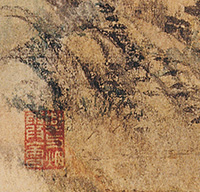Personal ethics and aesthetics
Seals - identity and expression
There is one further seal on Wang's painting in the lower left corner. This was applied by a later collector and is tucked away, discretely. Generally collectors took this modest stance, typically applying seals across the lower edge of an image and its mounting, or on the mounting itself. In the case of handscrolls or albums, later collectors might even apply their seal to parts of the scroll that were substantially removed from the image. Or, if they were capable calligraphers, their seal might simply accompany their own signature on a laudatory inscription.
Only in rare cases did collectors 'impose' themselves prominently on the image. The best-known example being the emperor Qianlong (乾隆, 1711-1799), whose interventions – both inscriptions and seals - often verge on destructive graffiti. On this work by WEN Dian (文點 1633-1704), Qianlong's inscription and three seals dwarf those of the artist himself. The tone and manner of Qianlong's addition is at odds with the aesthetic trajectory of the painting that Wen had himself echoed and reinforced with a delicate inscription and gracefully formed seal.

